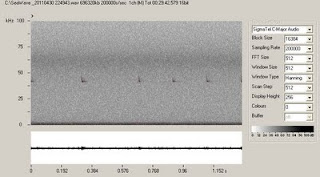SeaWave Software Review
Most will agree, that It's always nice to try something new, and different. Well, a new (free) audio application has been developed and recently released, it's called SeaWave. It is a light version of the SeaPro software package, developed by CIBRA and AEST in Italy.
You can read more about SeaWave, and download the free software here: http://www-3.unipv.it/cibra/seawave.html
There, you'll find a self-extracting file. The software includes an easy-to-understand User Guide. This application was mainly developed for bioacoustic studies, and performs many functions very well, in real time. Not only is it excellent for ultrasound recording, but it's also very good for all Nature and Wildlife Sound Recording.
It's a neat little program, I like the fact that it's small in size (for downloading, installation, and use). It's a very fast download and install process. And, it's very easy to use, right from the start. Despite it's small size, in use, it's a robust application. By default, the program launches into a mid-sized window. I routinely run multiple instances of the software. And, in all the time I've used it: I've never had the application crash, freeze, or report any errors - So, that's a plus. As you will see, this new sound recording application has lots of neat little features. It has useful and desirable options available, without having any useless or complicated options to fuss over. The way it allows a user to capture sound recordings is simple. Some of the sound recording software available these days have more options than one knows what to do with. At times, a Recordist may prefer a recording interface that isn't too "busy" or complicated. Or, one that doesn't require a lot of computer system resources. Seawave is a "low-overhead" program; in other words, it doesn't need a lot of system resources to run.
Some of the features that I really like are:
The Real Time Controls
In the lower, right-hand side of the application's dialog box is the Digital Gain feature: This can be increased/decreased while recording or during playback of recorded files. I find it very convenient.
The default setting is 1, but it may be incremented to: 2, 4, 6, 8, etc. This control provides digital amplification of the waveform (and does not affect recording).
You can watch the time representation of the recording (during playback) and if you see or hear an interesting sound - You can just type the time of the event into the GoTo box, and click the GoTo button. This can be done while the file is still playing (no need to stop the playback, etc.). The application will then begin playing the recording again, starting at the time you entered. Great!
The Tracker box may be ticked, activating a feature that tracks the dominant frequency. If using the software in it's default, gray-scale mode: The loudest frequencies will be indicated in red.
The automatic file naming: The program will, by default, name each recorded sound file as 'Seawave_20110512 205758' Basically, the date "_20110512" followed by (combined with) a file number. The fact that the current date is used, as part of the file-name is convenient.
The default settings of the program displays the spectrograph in gray-scale. This software produces a nice, high-resolution spectrogram, even in it's default gray-scale mode. But, a large selection of colour combinations and window types are available to the end user. Any picked-up, or recorded sounds stand out in stark contrast. In black, if using the gray-scale mode or in dark blue, etc. when using colour.
It is an especially useful program for active, "real-time" recording. As opposed to unattended recording. It may be used with lots of different standard microphones (using a computer's Microphone-In jack) or USB-based recording devices. I use it primarily with Dodotronic's Ultramic200K. The software has a template built-in for this microphone. When the microphone is plugged in to the system, the template becomes available, under the 'Quick Settings' drop-down menu. 'Ultramic200k 16 Bit' may then be selected from the menu.
The Disk Recording feature in the 'Basic Settings' section allows you to set the Rec Path on your system's hard drive. This is useful, of course, to set a drive or folder path that has plenty of free space to hold the SeaWave recordings. They are very easy to play, analyze, etc. later. And any file, sound recording or otherwise, created by SeaWave may be easily deleted - just as you would any other file.
For advanced needs, there is SeaPro Software. A trial version may be obtained by sending the Developer an e-mail request here: http://www-3.unipv.it/cibra/seapro.html
In the latest version of SeaPro, made available on May 6th 2011, an additional feature was made available: The buffer.
With the the buffer enabled (you may set the size in megabytes, in the quick settings panel).
Also added, is a setting for a 192k sampling rate, in case the user prefers
to cut down a few kHz but have a more standard file.
The creator of SeaWave and SeaPro (Gianni Pavan) hopes to get some feedback from users, in order to further fine-tune the program to user's needs.
Field Testing
This software works very well with Dodotronic's new Ultramic200K, the first fully digital ultrasonic USB microphone. The combination makes an awesome (and very sensitive!) recording set-up!
Many of the utilities and features of the software are designed to be monitored and used in real time. A lot of the functions and adjustments can be made while the system is recording (or playing-back).
I use the software mostly for recordings of night singing insects and bats. And, it performs very well indeed. I have just barely "scratched the surface" of all that can be done with this software.
I urge readers to visit the site, download Seawave, and try it out. After all, one can never have too many sound recording applications, can they?
(A sample sonogram will be added to this post soon)
-Al











